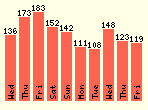| Wednesday, November 19, 2003 |  |
|
|
|
 19 Nov 2003 @ 10:41 19 Nov 2003 @ 10:41
My father arrived in the United States as a 16 year old teen when there were signs up that said "no Filipinos or dogs allowed" posted in some public places. Hard to believe, huh?
1964 was not that long ago, which is when desegregation came into legislation. I was in the 4th grade. We had no blacks in our school and only a hand full of Mexican and Filipinos. In 1967 my best friend's father (white male and manager of the local J C Penny Store) told his daughter that "she should be hanging around people her own kind". In the early 1970's I was admitted to a Los Angeles, CA hospital for surgery as "other white" (go figure!).
Racism continues to hurt and confuse many, including me at times. I, along with many others work to create bridges of understanding where "difference" is not valued as "better" or "less than". Here is a good reference.
When I read the article below, I was reminded again about the work of Candace Pert and her book Molecules of Emotion. Candace says, "Your body is your subconscious mind" Here is an article on her Theory. Prejudices (racism) are not just in the brain, it lives in the body as well.
The HeartMath Inst teaches us that if we change our heart, our mind will follow!
By Shaoni Bhattacharya New Scientist November 17, 2003
People with implicit racial prejudices are left mentally exhausted after interacting with someone from a different race, perhaps because they are trying to quell their feelings.
The new study, the first of its kind, shows that areas in the brain associated with self-control light up in white people with implicit racial biases when they are shown images of black people.
Furthermore, the study showed that the level of this brain activity correlated very closely with poor performance in a test of thinking ability given right after a face-to-face interview with a black person. The researchers believe this indicates that the subject's mental resources have been temporarily drained by their efforts to suppress their prejudices.
Jennifer Richeson, who led the study, was surprised by the results. She believes it is now important to understand these neurological responses. "If we can understand the mechanism underlying this effect, we may be able to do something to intervene," Richeson, at Dartmouth College in New Hampshire, told New Scientist . More >
|
|
|
|
|
 19 Nov 2003 @ 08:30 19 Nov 2003 @ 08:30
Jane's speech is circulating the net this week. When it hit my inbox, it seemed to thread through the other Conversations I have been sharing with many, many women both on the net and in my communities. Feminism after 30 years has deepened with compassion, without losing the passion for Life - All Life.
Enjoy!
Jane Fonda's Speech at the National Women's Leadership Summit
Washington, D.C. June 12, 2003
Before I turned sixty I thought I was a feminist. I was in a way - I worked to register women to vote, I supported women getting elected. I brought gender issues into my movie roles, I encouraged women to get strong and healthy, I read the books we've all read. I had it in my head and partly in my heart, yet I didn't fully get it.
See, although I've always been financially independent, and professionally and socially successful, behind the closed doors of my personal life I was still turning myself in a pretzel so I'd be loved by an alpha male. I thought if I didn't become whatever he wanted me to be, I'd be alone, and then, I wouldn't exist.
There is not the time nor is this the place to explain why this was true, or why it is such a common theme for so many otherwise strong, independent women. Nor is it the time to tell you how I got over it (I'm writing my memoirs, and all will be revealed). What's important is that I did get over it. Early on in my third act I found my voice and, in the process, I have ended up alone but not really. You see, I'm with myself and this has enabled me to see feminism more clearly. It's hard to see clearly when you're a pretzel.
So I want to tell you briefly some of what I have learned in this first part of my third act and how it relates to what, I think, needs to happen in terms of a revolution.
Because we can't just talk about women being at the table - it's too late for that - we have to think in terms of the shape of the table. Is it hierarchical or circular (metaphorically speaking)? We have to think about the quality of the men who are with us at the table, the culture that is hovering over the table that governs how things are decided and in whose interests. This is not just about glass ceilings or politics as usual. This is about revolution, and I have finally gotten to where I can say that word and know what I mean by it and feel good about it because I see, now, how the future of the earth and everything on it including men and boys depends on this happening.
Let me say something about men: obviously, I've had to do a lot of thinking about men, especially the ones who've been important in my life, and what I've come to realize is how damaging patriarchy has been for them. And all of them are smart, good men who want to be considered the "good guys." But the Male Belief System, that compartmentalized, hierarchical, ejaculatory, and centric power structure that is Patriarchy, is fatal to the hearts of men, to empathy and relationship.
Yes, men and boys receive privilege and status from patriarchy, but it is a poisoned privilege for which they pay a heavy price. If traditional, patriarchal socialization takes aim at girls' voices, it takes aim at boys' hearts - makes them lose the deepest, most sensitive and empathic parts of themselves. Men aren't even allowed to be depressed, which is why they engage so often in various forms of self-numbing, from sex to alcohol and drugs to gambling and workaholism. Patriarchy strikes a Faustian bargain with men.
Patriarchy sustains itself by breaking relationship. I'm referring here to real relationship, the showing-up kind, not the "I'll stay with him cause he pays the bills, or because of the kids, or because if I don't I will cease to exist," but relationship where you, the woman, can acknowledge your partner's needs while simultaneously
acknowledging and tending to your own. I work with young girls and I can tell you there's a whole generation who has not learned what a relationship is supposed to feel like - that it's not about leaving themselves behind.
Now, every group that's been oppressed has its share of Uncle Toms, and we have our Aunt Toms. I call them ventriloquists for the patriarchy. I won't name names but we all know them. They are women in whom the toxic aspects of masculinity hold sway. It should neither surprise nor discourage us. We need to understand it and be able to explain it to others, but it means, I think, that we should be just about getting a woman into this position or that. We need to look at "is that woman intact emotionally," has she had to forfeit her empathy gene somewhere along the way for whatever reason?
And then, of course, there are what Eve Ensler calls Vagina-Friendly men, who choose to remain emotionally literate. It's not easy for them - look at the names they get called: wimp, pansy, pussy, soft, limp, momma's boy. Men don't like to be considered "soft" on anything, which is why more don't choose to join us in the circle. Actually, most don't have the choice to make. You know why? Because when they are real little (I learned this from Carol Gilligan), like five years or younger, boys internalize the message of what it takes to be a "real man." Sometimes it comes through their fathers who beat it into them. Sometimes it comes because no one around them knows how to connect with their emotions (This is a generational thing). Sometimes it comes because our culture rips boys from their mothers before they are developmentally ready. Sometimes it comes because boys are teased at school for crying. Sometimes it's the subliminal messages from teachers and the media. It can be a specific trauma that shuts them down. But, I can assure you, it is true to some extent of many if not most men, and when the extreme version of it manifests itself in our nation's leaders, beware!
Another thing that I've learned is that there is a fundamental contradiction not just between patriarchy and relationship, but between patriarchy and Democracy. Patriarchy masquerades as Democracy, but it's an anathema. How can it be democracy when someone has to always be above someone else, when women, who are a majority, live within a social construct that discriminates against them, keeps them from having their full human rights?
But just because Patriarchy has ruled for 10,000 years since the beginning of agriculture, doesn't make it inevitable.
Maybe at some earlier stage in human evolution, Patriarchy was what was needed just for the species to survive. But today, there's nothing threatening the human species but humans. We've conquered our predators, we've subdued nature almost to extinction, and there are no more frontiers to conquer or to escape into so as to avoid having to deal with the mess we've left behind. Frontiers have always given
capitalism, Patriarchy's economic face, a way to avoid dealing with its shortcomings. Well, we're having to face them now in this post-frontier era and inevitably - especially when we have leaders who suffer from toxic masculinity - that leads to war, the conquering of new markets, and the destruction of the earth.
However, it is altogether possible, that we are on the verge of a tectonic shift in paradigms - that what we are seeing happening today are the paroxysms, the final terrible death throes of the old, no longer workable, no longer justifiable system. Look at it this way: it's Patriarchy's third act and we have to make sure it's its last.
It's possible that the extreme, neo-conservative version of Patriarchy which makes up our current Executive branch will over-play its hand and cause the house of cards to collapse. We know that this new "preventive war" doctrine will put us on a permanent war footing. We know there can't be guns and butter, right? We learned with Vietnam. We know that a Pandora's box has been opened in the Middle East and that the administration is not prepared for the complexities that are emerging. We know that friends are becoming foes and angry young Muslims with no connection to AlQaeda are becoming terrorists in greater numbers. We know that with the new tax plan the rich will be better off and the rest will be poorer. We know what happens when poor young men and women can only get jobs by joining the military and what happens when they come home and discover that the day after Congress passed the "Support Our Troops" Resolution, $25 billion was cut from the VA budget. We know that already, families of servicemen have to go on welfare and are angry about it.
So, as Eve Ensler says, we have to change the verbs from obliterate, dominate, humiliate, to liberate, appreciate, celebrate. We have to make sure that head and heart can be reunited in the body politic, and relationship and democracy can be restored.
We need to really understand the depth and breadth of what a shift to a new, feminine paradigm would mean, how fundamentally central it is to every single other thing in the world. We win, everything wins, including boys, men, and the earth. We have to really understand this and be able to make it concrete for others so they will be able to see what Feminism really is and see themselves in it.
So our challenge is to commit ourselves to creating the tipping point and the turning point. The time is ripe to launch a unified national movement, a campaign, a tidal wave, built around issues and values, not candidates.
That's why V-Day, The White House Project and their many allies are partnering to hold a national women's convention somewhere in the heartland, next June of 2004. Its purpose will be to inspire and mobilize women and vagina-friendly men around the 2004 elections and to build a new movement that will coalesce our energies and forces around a politic of caring.
The convention will put forward a fresh, clear, and concise platform of issues, and build the spirit, energy and power base to hold the candidates accountable for them. There will be a diversity of women from across the country who will participate in the mobilization. There will be a special focus on involving young women. There will be a variety of performers and artists acknowledging that culture plays a powerful role in political action. There will be a concurrent internet mobilization. Women's organizations will be asked to sign on and send representatives to the convention.
There will be a caravan, a rolling tour across the country, of diverse women leaders, celebrities and activists who will work with local organizers to build momentum, sign people up, register them to vote, get them organized and leave behind a tool kit for further mobilization through the election and beyond.
This movement will be a volcano that will erupt in a flow of soft, hot, empathic, breathing, authentic, vagina-friendly, relational lava that will encircle patriarchy and smother it. We will be the flood and we'll be Noah's ark.
Please copy this and paste it and send it to all the women you know. What we have been envisioning for decades is upon us. The time is here.
Maureen Walsh
Publisher
Life Works Books and co-author of
The Female Power Within - A Guide to Living a Gentler More Meaningful Life
There is NO PRINCE and Other Truths Your Mother Never Told You
How to Be Cherished - a Guide to Having the Love You Desire - Jan 2004
|
|
| Tuesday, November 18, 2003 |  |
|
|
|
 18 Nov 2003 @ 12:49 18 Nov 2003 @ 12:49
I just got off the phone with Julie. And I had just read Ming's blog entry about London where he and Julie met up with other bloggers. How I miss them being with me in California and our Synchronicity Vortex.
I am reminded how important it is to link in with people we love and who know our true nature. Though we may not be physically in the same place, we can feel connected through the web of life. We are different, yet the same. Having our own unique experiences and sharing a common energy that seems to be transforming us from the inside out.
I know the energy as Love. I know/trust they stand with me in this....
Moment of Change
I move through “no-thingness”
the Void
Chaos
Undone by my own making
I have arrived at the Inbetween place
The place of letting go
The full release
The Sacred Pause
Silence…
The mind wants to grasp an Edge
The edge of known reality
All shapes
And forms
Of “I”
Released from Particle to Wave
No where
And everywhere
Whirling around me the Past and the Future
I live in the Light of Change
I am in the Becoming
Letecia Layson
November 8, 2003
Taurus Full Moon Eclipse
Harmonic Concordance
|
|
|
|
|
18 Nov 2003 @ 08:58
BOSTON -- The highest court in Massachusetts has ruled that same-sex couples are legally entitled to wed under the state Constitution, but stopped short of immediately allowing marriage licenses to be issued to the seven couples who challenged the law.
For full details check here
|
|
|
|
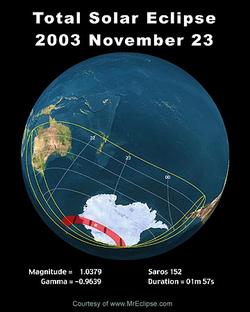 18 Nov 2003 @ 11:34 18 Nov 2003 @ 11:34
On Sunday, 2003 November 23, a total eclipse of the Sun will be visible from within a narrow corridor which traverses the far Southern Hemisphere. The path of the Moon's umbral shadow begins in the Indian Ocean, and quickly sweeps over portions of Antarctica. A partial eclipse will be seen within the much broader path of the Moon's penumbral shadow, which includes most of Australia and New Zealand, southernmost South America, and all of Antarctica.
For more details check here or here
In California the Total Solar Eclipse is at 2:50PM and the New Moon is Sagittarius is at 2:59pm
|
|
|
|
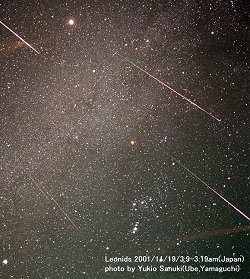 18 Nov 2003 @ 11:26 18 Nov 2003 @ 11:26
Space Weather News for Nov. 18, 2003
The 2003 Leonid meteor shower began on Nov. 13th with a mild flurry of meteors over the Pacific Ocean. It continues on Wednesday morning, Nov. 19th, with a much stronger peak over the Americas and western Europe.
Sky watchers on the Atlantic side of North America are favored; they could see as many as 80 meteors per hour between 1:30 a.m. and 4:00 a.m. local time. Western Europeans and South Americans ought to have a good view, too, shortly before local sunrise. (All these times refer to Wednesday morning, Nov. 19th.)
In western North America and around the Pacific Ocean the display will be weaker, perhaps 20 to 40 meteors per hour, but that's still a nice shower. Favored sites include Alaska and Hawaii before dawn on Nov. 19th and Japan after local midnight on Nov. 20th.
|
|
|
|
 18 Nov 2003 @ 11:10 18 Nov 2003 @ 11:10
By Dr David Whitehouse BBC News Monday, November 17, 2003
The giant sunspots that produced the largest explosion ever seen on the surface of our star are set to return.
They are moving back into view of the Earth after being carried to the Sun's far side by its 27-day rotation period.
Astronomers say that even out of direct vision the spots have continued to eject clouds of super-hot material.
The spots will point Earthwards again on 19 November. Although still very active, they are not expected to give out another X28-class solar fare.
Other side
Sunspot groups 486 and 488 produced record-breaking explosions earlier this month even though the Sun is supposed to be entering a period of declining activity - the peak of its 11-year cycle was a few years ago.
As the Sun's rotation took the groups out of view, astronomers were still able to keep an eye on them using a technique called helioseismic holography.
This allows the scientists to "look through" the Sun to see spot activity on the far side.
The holographic maps revealed 486 and 488 to still be active.
While on the far side of the Sun, explosions from their vicinity have been hurling clouds of gas over the Sun's limb in recent days.
Build up
The Sun's rotation will soon carry the pair back to the Earth-facing side of the star.
As they are still active, astronomers believe we are set for more solar storms when they reappear on or about Wednesday.
Indeed, the precursors to the giant sunspot group are just reappearing with the active region 484 just peeking over the Sun's eastern limb.
The spot looks smaller than it did in late October, but it too remains active - hurling a bright mass ejection into space on 13 November.
|
|
|
|
 18 Nov 2003 @ 08:46 18 Nov 2003 @ 08:46
It's that time of year again and the Winter Solstice Fair is here! Saturday, December 6th at the Unitarian Universalist Church of Long Beach 5450 Atherton (west of Bellflower between 405 and 7th Street) 10AM - 4PM $5 Admission - includes one raffle ticket
New Vendors and Returning Favourites
Networking Table - bring your flyers and brochures to share
Hourly Raffle - Items from each vendor are raffled
All Day Entertainment including Luna Party with Chris Gasci Kahena & her dance troupe with "Moonlight Dancing: Take Back the Night" Cyntia Smith and the Lilies Anniitra Ravenmoon Lisa Thiel
Event sponsored by LBWS and Temple of Isis/Los Angeles (Event not sponsored by UUCLB)
|
|
|
|
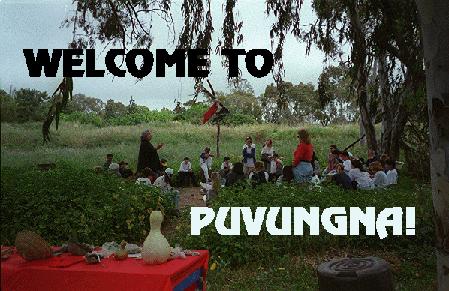 18 Nov 2003 @ 07:25 18 Nov 2003 @ 07:25
Puvungna, Long Beach
We invite all who have a song to share and a good heart to sing. All who want to sing with others in harmony and peace.
Bring songs to sing, clappers, rattles, chair, water, a little sage to burn
We will be sharing our California songs and making clapper sticks.
The Land wants us to sing the songs. Our Spirit wants us to sing the songs. Singing is deep-rooted in our traditions: a profound form of prayer. Our hearts join the Circle as we dedicate our songs to the well-being of All That Is.
Note: Puvungna is the Indian village which once occupied the land where Cal State Long Beach now stands. Puvungna remains sacred to the Gabrielino and other Indian people as a spiritual center from which their lawgiver and god -- Chungichnish -- instructed his people.
Ethnohistoric evidence clearly identifies Puvungna with Rancho Los Alamitos, a portion of which became the Cal State Long Beach campus. More than a dozen archaeological sites spread over an area of about 500 acres on and near our campus have been identified as Puvungna village sites. Most of these have been destroyed by development.
|
|
| Monday, November 17, 2003 |  |
|
|
|
 17 Nov 2003 @ 07:46 17 Nov 2003 @ 07:46
P&G, WAL-MART STORE DID SECRET TEST OF RFID
By Howard Wolinsky Chicago Sun-Times November 9, 2003
Shoppers in a suburban Tulsa, Okla., Wal-Mart were unwitting guinea pigs earlier this year in a secret study that two of America's largest corporations never expected you'd know about.
In the study, uncovered by the Chicago Sun-Times, shelves in a Wal-Mart in Broken Arrow, Okla., were equipped with hidden electronics to track the Max Factor Lipfinity lipstick containers stacked on them. The shelves and Webcam images were viewed 750 miles away by Procter & Gamble researchers in Cincinnati who could tell when lipsticks were removed from the shelves and could even watch consumers in action.
The study involved a new technology, known as Radio Frequency Identification (RFID), that enables retailers to use radio signals to electronically track products in warehouses and on store shelves, a technology critics fear ultimately could be used to track people once they leave the store.
Manufacturers and retailers are looking at ultimately putting the tiny chips into everything from soda cans and cereal boxes to shoes, clothing and car tires.
This worries privacy-rights advocates who envision tags in shoes and other personal items being linked to credit-card information so that retailers and government agencies could spy on the public.
NOTE: How scary is this? To read the who article go here.
To read another article on RFID go here.
|
|
| Sunday, November 16, 2003 |  |
|
|
|
 16 Nov 2003 @ 21:29 16 Nov 2003 @ 21:29
By Andrew Gumbel in Los Angeles The Independent
November 9, 2003
An unprecedented array of US intelligence professionals, diplomats and former Pentagon officials have gone on record to lambast the Bush administration for its distortion of the case for war against Iraq. In their view, the very foundations of intelligence-gathering have been damaged in ways that could take years, even decades, to repair.
A new documentary film beginning to circulate in the United States features one powerful condemnation after another, from the sort of people who usually stay discreetly in the shadows -- a former director of the CIA, two former assistant secretaries of defence, a former ambassador to Saudi Arabia and even the man who served as President Bush's Secretary of the Army until just a few months ago.
Between them, the two dozen interviewees reveal how the pre-war intelligence record on Iraq showed virtually the opposite of the picture the administration painted to Congress, to US voters and to the world. They also reconstruct the way senior White House officials -- notably Vice-President Dick Cheney -- leaned on the CIA to find evidence that would fit a preordained set of conclusions.
Note: To read the full article go here
|
|
|
|
 16 Nov 2003 @ 00:22 16 Nov 2003 @ 00:22
By Helen Phillips New Scientist November 12, 2003
When you first fall in love, you are not experiencing an emotion, but a motivation or drive, new brain scanning studies have shown.
The early stages of a romantic relationship spark activity in dopamine-rich brain regions associated with motivation and reward. The more intense the relationship is, the greater the activity.
The regions associated with emotion, such as the insular cortex and parts of the anterior cingulate cortex, are not activated until the more mature phases of a relationship, says Helen Fisher, an anthropologist from Rutgers University in New Jersey.
Fisher and colleagues recruited seven male and 10 female volunteers who claimed to be madly in love. They asked them to look at pictures of either their loved one or another familiar person while inside a functional MRI scanner.
Eating chocolate
Early on in a relationship, the images showed that the brain seems to be very focused on planning and pursuit of pleasurable reward, says Fisher, mediated by regions called the right caudate nucleus and right ventral tegmentum. The same regions become active when a person enjoys the pleasure of eating chocolate, she adds.
There are also patterns that resemble aspects of obsessive compulsive disorder. "Activity in one particular area of the anterior cingulate cortex is in common," says Lucy Brown, a neuroscientist from Albert Einstein College of Medicine in New York, who was part of the research team. "The activity is correlated with the length of a relationship, lasting just into the emotional stage."
There are some differences between love-struck men and women, says Fisher. Women in love show more emotional activity earlier on in a relationship. They also seem to quiz their memory regions as they look at pictures of their partner, perhaps paying more attention to their past experience with them.
For men, perhaps unsurprisingly, love looks a little more like lust, with extra activity in visual areas that mediate sexual arousal.
The team has since moved on to examining the final phase of romance. "We are now looking at people who have just been rejected," says Fisher. The research was presented at the Society for Neuroscience's meeting in New Orleans on Tuesday.
|
|
| Saturday, November 15, 2003 |  |
|
|
|
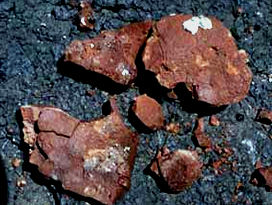 15 Nov 2003 @ 08:40 15 Nov 2003 @ 08:40
The discovery of 71 pieces of red ochre in the oldest section of a burial cave in Israel has prompted researchers to suggest that the symbolic thinking that marked the beginning of modern-day human thought arose deep in the Stone Age. The received wisdom has been that the assignment of symbolic meaning to specific items and colours emerged no earlier than 50,000 years ago. But the association of red ochre with skeletons found in the oldest section of the Qafzeh Cave has been taken to indicate that symbolic burial rites were being performed more than 90,000 years ago.
The controversial theory that modern thought did not emerge with the appearance of Upper Paleolithic cultures has been put forward by Erella Hovers of the Hebrew University of Jerusalem, who directed the Qafzeh project. She argues that in the Middle East and Eurasia "many symbolic behaviours that are considered modern existed for a time [before the Upper Paleolithic] and then disappeared, to be reinvented time and again". The 'continual reinvention' proposal stems from the fact that similar ochre use does not appear again in the Qafzeh Cave until 12,700 years ago.
Red ochre is a form of iron oxide which yields a pigment when heated. The precise meaning of the use of ochre is unknown, but it was widely used in primitive societies and even today the colour red is used in non-industrial cultures as a symbol of fertility or vitality. The ochre at Qafzeh was brought to the cave from nearby sources. Large hearths and ochre-stained tools in the same sediment levels that contain the oldest human remains show that the ochre was worked on-site. Hovers and her co-workers say that the pigment was used with the shells of inedible molluscs found in the cave, possibly in symbolic activities related to burying the dead. Prehistoric symbolic expressions most commonly occurred in large populations that stayed for extended periods in resource-rich locations, says Hovers. But in the small nomadic groups typical of Stone Age Middle East symbolic behaviour would have surfaced for special activities at special sites, such as interment of the dead at Qafzeh Cave.
A report published in the August-October Current Anthropology has had a mixed reception. Sally McBrearty of the University of Connecticut believes that Qafzeh adds to the evidence of the great antiquity of the colour red as a symbolic category, pointing out that engraved ochre dates to 77,000 years ago in South Africa. On the other hand, Richard G. Klein of Stanford University holds that ochre use was merely a step towards advanced symbolic culture, which he places at around 50,000 years ago.
Source: Science News (1 November 2003)
NOTE: If you want to follow the Scarlet Thread, take a look a Julie's blog where she posts another exerpt from her book in progress.
|
|
|
|
 15 Nov 2003 @ 07:21 15 Nov 2003 @ 07:21
Space Weather News for Nov. 14, 2003
Using a technique called helioseismic holography, astronomers can do something amazing: look through the sun to find sunspots on the far side of our star. On Nov. 11th and 12th their holographic maps revealed giant sunspots 486 and 488--the same active regions that caused so much intense space weather a few weeks ago.
These spots are still active. Explosions from their vicinity have been hurling clouds of gas over the sun's limb in recent days. The sun's 27-day rotation will soon carry the pair around to the Earth-facing side of the sun. More solar storms are possible when they reappear on or about Nov. 19th.
Meanwhile, another one of last month's giant sunspots has already reappeared. Active region 484 is peeking over the sun's eastern limb. The sunspot looks smaller than it did in late October, but it too remains active--hurling a bright coronal mass ejection into space on Nov. 13th.
|
|
|
|
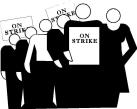 15 Nov 2003 @ 07:16 15 Nov 2003 @ 07:16
ANTI-WAR/COMMUNITY ACTIVISTS LAUNCH FOOD DRIVE TO SUPPORT STRIKING GROCERY WORKERS KICK-OFF PRESS CONFERENCE AND RALLY TO TAKE PLACE ON SATURDAY
NOV. 15 at 11:00 AM Los Angeles, CA
Join hundreds of working families, community leaders, anti-war activists, striking workers and their families at the VONS Grocery Store at 1430 S. Fairfax Ave. Community support is growing for the just struggle of the striking workers and their families for decent pay, union rights, and medical benefits
The International ANSWER Coalition, has created the Community Action Project to Support Labor (CAPSL). This week CAPSL is initiating a mass community food drive in support of the striking and locked-out UFCW grocery workers fighting to protect their health benefits. FOOD DROP OFF CENTERS ARE NOW LOCATED IN TARZANA, KOREATOWN, SOUTH CENTRAL L.A., AND VENICE.
Hear: Community Leaders and Activists, Striking workers and their families including:
Rev. Richard Byrd, KRST Unity Center for African Spirituality in Los Angeles Ely Orozco, locked out UFCW worker and labor activist Jim Franklin, UFCW Local 770 Executive Board Member and Business Agent, Member Inglewood City Council Jim Lafferty, Executive Director, National Lawyers Guild Juan Jose Gutierrez, Director of Latino Movement USA John Parker, Community Action Project to Support Labor John Heard, Actor Pam Afrika, Int?l Concerned Family and Friends of Mumia Abu-Jamal Music by Rap Artist Will Be ************************************************************
Please consider making a donation to the important work of the ANSWER Coalition. Log on to www.answerla.org to use Paypal, call 213 487-2368 to use Mastercard or Visa by phone, or mail check to: ANSWER 422 S Western Ave, Rm 114 L.A., CA 90020
Note: for more info check here or here
|
|
|
|
 15 Nov 2003 @ 00:01 15 Nov 2003 @ 00:01
By Samisoni Pareti Associated Press November 13, 2003
NABUTAUTAU, Fiji (AP) - Villagers in a remote Fijian community staged an elaborate ceremony of apology Thursday for the relatives of a British missionary killed and eaten here 136 years ago.
The Rev. Thomas Baker and eight Fijian followers were killed and devoured by cannibals in 1867 in the village of Nabutautau, high in the hills of the South Pacific island of Viti Levu. Residents say their community has been cursed ever since.
In a mixture of ancient pagan and modern Christian rites, the villagers have staged a series of ceremonies hoping to erase the misfortunes they believe have kept them poor.
The rituals - which started about a month ago - culminated Thursday with the offering of cows, specially woven mats and 30 carved sperm-whale teeth known as tabua to 10 Australian descendants of Baker.
``This is our third apology but, unlike the first two, this one is being offered physically to the family of Mr. Baker,'' Ratu Filimoni Nawawabalavu, the village's chief, told The Associated Press.
Nawawabalavu is the great-grandson of the chief responsible for cooking the missionary in an earthen oven.
Past apologies have not helped. In 1993, villagers presented the Methodist Church of Fiji with Baker's boots - which cannibals tried unsuccessfully to cook and eat.
There are differing accounts of Baker's demise. A villager said last month the incident started when the chief borrowed Baker's hat. Baker tried to take it back without knowing that touching a chief's head was taboo and punishable by death.
Others say the missionary lent the chief a comb, then touched his head as he tried to retrieve it from the chief's tight, curly hair.
Villagers believe that since 1867, either Baker's spirit or disapproving gods have made sure that modern developments like electricity, a school, piped water supply and other essentials enjoyed by most Fijian villagers have been kept from them.
It was only two weeks ago that a logging company cut a track to the village. Prime Minister Laisenia Qarase, who flew into the village by helicopter for the ceremony, is leading a campaign to improve life in isolated areas.
Fiji, a nation of 320 islands, is about 2,250 miles northeast of Sydney, Australia.
|
|
|
|
  15 Nov 2003 @ 00:01 15 Nov 2003 @ 00:01
14:32 01 October 03
NewScientist.com
Early female-dominated societies lost their power to men as they acquired cattle, a new study demonstrates.
The idea that early communities became "patrilineal", with male status and inheritance being most important, when they gained cattle has been debated since the beginning of modern anthropological studies in the nineteenth century. However, no one had been able to convincingly demonstrate a causal link.
Now Clare Janaki Holden and Ruth Mace at University College London, UK, believe they have produced some of the firmest evidence yet to back the theory.
They made a linguistic tree of the evolution of 68 African Bantu languages, which include modern day Swahili and Zulu, and correlated this with the acquisition of cattle herds by those language speakers and the type of society they lived in.
The researchers then used a clever mathematical model to infer what had happened in the past to produce the pattern of languages seen today. "At an early stage these populations were more matrilineal than today," Holden told New Scientist. "They then adopted cattle and became patrilineal."
"I think this study is very important," says Mark Pagel, an evolutionary biologist at the University of Reading, UK. "What they are trying to show is that human mating patterns, wealth inheritance and dominance systems respond to ecological variation in the same way that we would expect animal populations to behave."
Bride wealth
Holden believes reason the acquisition of cattle led to a switch to male-dominated societies is most probably linked to the system of "bridewealth". This tradition, in which a bridegroom gives cattle to a bride's family, is particular to the Bantu speaking regions of sub-equatorial Africa.
"If a man's got lots of cattle he can have lots of wives. So if you have cattle it makes sense to give it to sons rather than the daughters," she says. The fundamental reason for this is that wealthy, and therefore attractive, sons are likely to have more children than daughters, because while women must bear each child a man need only impregnate a woman.
Holden believes that the acquisition of wealth may generally causing a shift in power to men: "If you have valuable resources they are probably going to become monopolised by men because men can use them to acquire more wives or women."
Another factor that could be important, Holden says, is cattle raiding, with men better able to defend against marauders.
Maximum likelihood
The Bantu linguistic tree created by Holden and Mace charts the divergence of the languages from a common starting point about 3000 years ago. They then added data about each population's ownership of cattle and their type of society, matrilineal or patrilineal.
The pair then applied the mathematical model, developed by Pagel, to find the "maximum likelihood" historical scenario that would have produced the modern day situation. They found that acquiring cattle did indeed cause a shift to a man's world, or one of "mixed descent" where both sexes are important for inheritance.
Crucially, they were able to account for the fact that the cultures were related. Cultural traits tend to be passed down generations in the same way as genetic ones.
Pagel, who is also Mace's husband, says the study shows the cultural phenomenon arose independently a number of times and "greatly strengthens" the belief that the cattle ownership and patrilineal societies have a causal connection and are not observed together for some other reason.
Journal reference: Proceedings of the Royal Society B (DOI 10.1098/rspb.2003.2535)
Shaoni Bhattacharya
© Copyright Reed Business Information Ltd.
|
|
| Friday, November 14, 2003 |  |
|
|
|
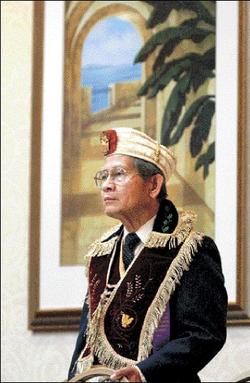 14 Nov 2003 @ 16:44 14 Nov 2003 @ 16:44
Shriners have the fez. Other clubs might have antlers.
By Emil Guillermo
RecordStaff Writer
Published Friday, November 14, 2003
But the fraternal organization known as the Legionarios del Trabajo of America have an apron, sash and fuzzy velure cap worn tight on the head.
If that appeals to you, you're in luck. They're looking for young, new members. And when you pay the $25 initiation fee and $15 annual dues, you'll get the secret password.
Until then, forget it.
"If you show me your membership card, I'm willing to give it to you," said Camila Carido, 92, the group's grand dame, who in 1935 was the first woman admitted to the organization in Stockton.
Carido and many of the 660 members of the Legionarios are meeting this weekend at the Radisson Hotel Stockton for their 14th triennial convention.
They're wondering how long they can keep it up. After 79 years, the organization, which has its roots as a support group for Filipino immigrants to America, finds its numbers dwindling.
Members are dying faster than new members are found. And its a double-whammy because the group, a legitimate nonprofit, is a mutual-aid society that gives a $3,500 death benefit to member families.
Last year, 55 members died. As they do, the funds dry up.
"We're paying out more than we take in," said Zosimo De Veas, 65, who is otherwise known as an illustrious brother and the group's grand master for the past nine years.
De Veas, an Internal Revenue Service employee who lives in Hercules, drives to Stockton each weekend to run the organization from its Grand Lodge on South San Joaquin Street.
Along with the lodge, the Legionarios own 160 acres of farmland in Lathrop that's currently leased out.
"They grow tomatoes," said Ernie Mabalon, 79, the group's supreme minister.
At this week's national meeting, some members suggested the group sell the farmland.
"Never," said Mabalon. "That was bought with the sweat of the old farm laborers."
Those early immigrants were the founders of the Legionarios, and included Filipino labor leaders like Larry Itliong, who some considered Cesar Chavez's right-hand man. Originally formed in Manila, the Legionarios was seen as the Filipino answer to the Free Masons.
The symbols and images are similar but with a heavy dose of Filipino national heroes and Christian ideals. Nevertheless, the group says it is nonsectarian and nondenominational and preaches tolerance.
When the group arrived in the United States in 1924, its main purpose was to serve as a social support system to the mostly male Filipino immigrants.
The hostile social pressures of the time, which included anti-intermarriage laws, made the Legionarios even more important to the Filipino community.
Today, however, the Legionarios are dying off. The one-time national group is down to a few chapters in California and Washington state.
Nowadays, a new, young member might be a 60 year-old doctor looking for people to socialize with.
"When you try to recruit a 25- to 26-year-old, they just say, 'Oh my God,'" said Felino Cabusora, 75, of Union City.
Cabusora joined three years ago for the fellowship, the club's tradition and the death benefit -- which could be reduced if the members keep dying off at a faster rate.
"Age and death have caught up with us," Mabalon said.
But so have the women. The one-time predominantly male organization is now two-thirds female.
"Will we have a woman grand master or mistress?" De Veas asked at Thursday's Ladies Conference Luncheon.
Carido, who is the mother of Stockton Vice Mayor Gloria Nomura, was honored at the luncheon and put the group's problem in more-direct terms.
"This is the last time to see all of you to give my love," said the 92-year-old.
But De Veas is more optimistic. The coronation ball today and the banquet Saturday are open to the public.
A big push for new members is planned.
And the year's almost over, and there are only 26 deaths.
If you join, you'll get the secret password, the sign and the handshake. Until then, don't ask.
"We keep it among ourselves," De Veas said.
"For members."
|
|
|
|
14 Nov 2003 @ 08:02
Solar maximum is years past, yet the sun has been remarkably active lately. Is the sunspot cycle broken?
NASANovember 12, 2003: Imagine you're in California. It's July, the middle of summer. The sun rises early; bright rays warm the ground. It's a great day to be outside. Then, suddenly, it begins to snow--not just a little flurry, but a swirling blizzard that doesn't stop for two weeks.
That's what forecasters call unseasonal weather.
It sounds incredible, but "something like that just happened on the sun," says David Hathaway, a solar physicist at NASA's Marshall Space Flight Center.
Only a few weeks ago solar activity was low. The face of the sun was nearly blank--"very few sunspots," says Hathaway--and space weather near Earth was mild. "Mild is just what we expect at this point in the 11-year solar cycle," he explains. "The most recent maximum was in 2001, and solar activity has been declining ever since."
Then, suddenly, in late October the sun began to behave strangely. Three giant sunspots appeared, each one larger than the planet Jupiter. In California where smoke from wildfires dimmed the sun enough to look straight at it, casual sky watchers were startled by the huge blotches on the sun. One of them, named "sunspot 486," was the biggest in 13 years.
Sunspots cause solar flares and, usually, the biggest flares come from the biggest spots. The three giant sunspots unleashed eleven X-class flares in only fourteen days--equaling the total number observed during the previous twelve months. "This was a big surprise," says Hathaway.
The effects on Earth were many: Radio blackouts disrupted communications. Solar protons penetrated Earth's upper atmosphere, exposing astronauts and some air travelers to radiation doses equal to a medical chest X-ray. Auroras appeared all over the world--in Florida, Texas, Australia and many other places where they are seldom seen.
Researchers rank solar flares according to their x-ray power output. C-flares are the weakest. M-flares are middling-strong. X-flares are the most powerful. Each category has subdivisions: e.g., X1, X2, X3 and so on. A typical X-flare registers X1 or X2. On Nov. 4th, sunspot 486 unleashed an X28 flare--the most powerful ever recorded.
"In 1989 a flare about half that strong caused a widespread power blackout in Quebec," recalls Hathaway. Last week's blast was aimed away from Earth, so its effects on our planet were slight--a bit of good luck.
All this happened two years after solar maximum, which raises a question: is something wrong with the solar cycle? Is the sun going haywire?
"Nothing's wrong," reassures Hathaway. The sun isn't about to explode, nor is the sunspot cycle broken. "These latest sunspots were whoppers," he allows, "but sunspot counts averaged over many weeks are still declining as predicted. We're still on course for a solar minimum in 2006."
Indeed, it's possible that what we've just experienced is a normal part of the solar cycle, speculates Hathaway. "There's a curious tendency for the biggest flares to occur after solar maximum--on the downslope toward solar minimum. This has happened during two of the last three solar cycles."
Consider the year 1984, says Hathaway. Sunspot counts were plunging, and the sun was rapidly approaching the 1985-86 solar minimum. Suddenly a giant sunspot appeared, Jupiter-sized like sunspot 486, and unleashed two dozen M-flares and three X-flares, including a remarkable flare registering X13. People then probably wondered too if the solar cycle was broken.
"It's hard to be sure what's normal and what's not," notes Hathaway. "Astronomers have been observing x-rays from the sun for only 35 years--or three solar cycles. We can't draw good statistical conclusions from so few data."
One thing is certain, though: flurries of solar activity can happen at any time. The next time, says Hathaway, could be just a week or so away.
Sunspot 486 and its companions are on the far side of the sun now, carried around by the sun's 27-day rotation. "We suspect they're still active," says Hathaway, because the Solar and Heliospheric Observatory--a sun-watching satellite--has photographed clouds of gas being thrown over the sun's limb by unseen explosions. Unless these sunspots dissipate, which could happen, they will reappear on the Earth-facing side of the sun beginning as early as Nov. 14th.
And then...? No one knows. "We might get some more unseasonal space weather," says Hathaway. But this time he won't be surprised.
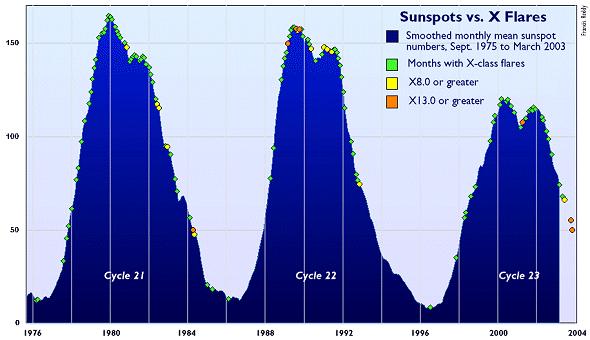
|
|
| Thursday, November 13, 2003 |  |
|
|
|
 13 Nov 2003 @ 23:59 13 Nov 2003 @ 23:59
Ananova November 6, 2003
Spending more time in the pub could be good for your brain.
Researchers from University College, London, found that while a drink with your friends may be bad for your waistline, it could be good for your mind.
In a study due to be published this month, they report on a direct link between the social aspects of going to the pub and improved verbal and numerical ability.
This contrasts starkly with more restrained activities such as gardening and painting which, the study found, had no benefit to the mind at all.
Psychologists from the university's Department of Epidemiology and Public Health analysed information on 10,000 civil servants of all grades working in London, says The Times .
The results, which were standardised to account for age and social class, were examined for connections between mental ability and the way that people spent their leisure time.
The researchers found that the best way to help the mind was by regular cultural visits to theatres, art galleries and stately homes.
This was closely followed by reading and listening to music. Involvement in clubs and voluntary organisations were also highly beneficial, as were taking part in courses and evening classes.
But the study, which will be published in the Journal of Epidemiology and Community Health, also found that social activities, like going to the pub, could be good for the mind.
The authors emphasise their study looked at social aspects alone and not the effect of beer on the brain.
|
|
<< Newer entries Page: 1 ... 8 9 10 11 12 ... 20 Older entries >> |
|
"In chaos theory, the edge is the meeting point between order and chaos, between the known and the unknown. In nature it is where creativity and self-organizing happen. It is where new information is created."
Dana Zohar & Ian Marshall
|
| Mon | Tue | Wed | Thu | Fri | Sat | Sun |
|---|
| 1 |
2 |
3 |
4 |
5 |
6 |
7 |
| 8 |
9 |
10 |
11 |
12 |
13 |
14 |
| 15 |
16 |
17 |
18 |
19 |
20 |
21 |
| 22 |
23 |
24 |
25 |
26 |
27 |
28 |
| 29 |
30 |
31 |
|
"Dancing is just discovery, discovery, discovery."
Martha Graham, Blood Memory |
|
